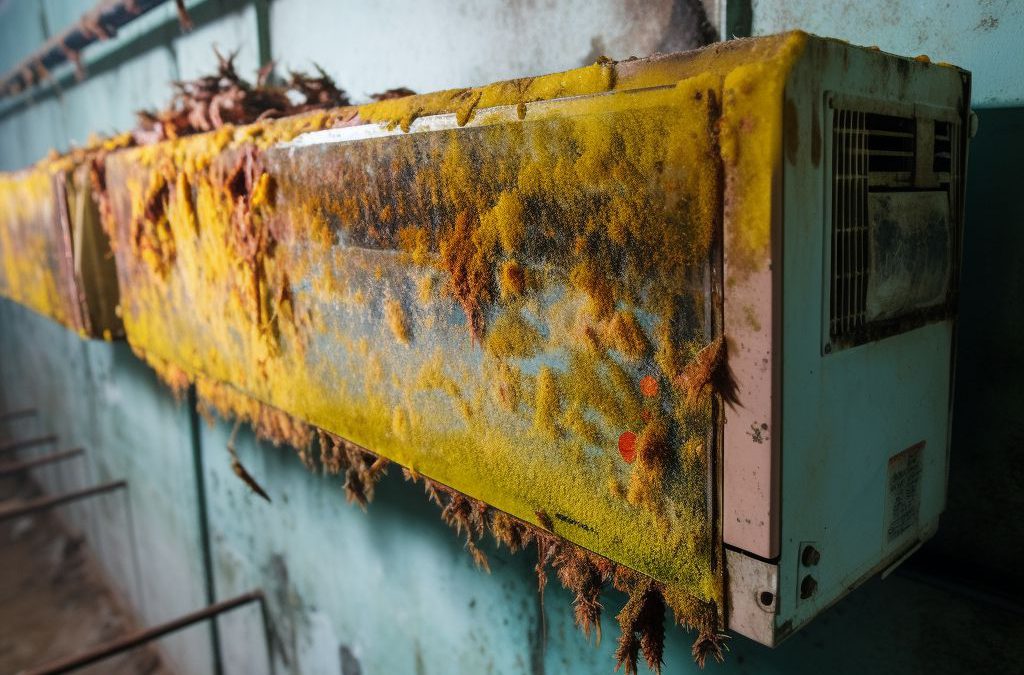Have you ever taken a look inside your air conditioner and noticed dark patches of mold growing? Maybe you’ve even started to notice a musty odor emanating from your unit. These issues not only affect the air quality of your home but can also lead to health problems and damage to your air conditioner’s internal components. If you’re wondering why mold is growing in your air conditioner and what you can do about it, look no further. In this informative article, we explain the causes of mold growth and how to prevent it from occurring in the future.
Tabe of Contents
- 1. Common Causes of Mold Growth in Air Conditioners: Understanding the Problem
- 2. How Humidity Levels Affect Mold Growth in Air Conditioning Units
- 3. The Importance of Regularly Maintaining Your Air Conditioning System
- 4. Signs of Mold Growth and How to Address the Problem
- 5. Effective Ways to Prevent Mold Growth in Your Air Conditioner
- People Also Ask
- Conclusion
1. Common Causes of Mold Growth in Air Conditioners: Understanding the Problem
Mold growth is a common problem that affects many air conditioning units. It can be an annoying and potentially harmful issue for homeowners, especially those who have allergies or respiratory problems.
There are several reasons why mold grows in air conditioning units. One of the most common causes is humidity levels. High levels of humidity provide the perfect environment for mold to thrive. When warm, moist air enters the air conditioner, it can create condensation on the unit’s coils. The moisture that accumulates on the coils can be a breeding ground for mold and other harmful bacteria.
Another reason why mold grows in air conditioning units is due to poor maintenance. Over time, dust and debris can build up inside the unit, providing an ideal environment for mold growth. A dirty air filter can also contribute to mold growth by trapping moisture and providing food for mold spores.
Additionally, if your air conditioning unit is undersized or oversized for your home, it may not provide adequate ventilation and air circulation. This can lead to higher humidity levels and stagnant air, which can encourage mold growth.
It’s essential to understand the common causes of mold growth in air conditioning units so that you can take appropriate measures to prevent it from happening in your home. By maintaining proper humidity levels, regularly maintaining your air conditioning unit, and ensuring adequate ventilation, you can reduce the risk of mold growth and create a healthier living environment for you and your family.
2. How Humidity Levels Affect Mold Growth in Air Conditioning Units
Mold thrives in humid environments, and air conditioners provide an ideal breeding ground for these fungi. When the humidity level inside your home is high, your AC system becomes a perfect spot for mold to grow. As air circulates through the air conditioner, moisture condenses on the coils, creating a moist environment that can promote mold growth.
If you live in an area with high humidity levels, your air conditioning system is particularly susceptible to mold growth. The higher the humidity levels, the more likely it is that mold will grow inside your AC unit. Therefore, it is essential to keep your home’s humidity levels low to prevent mold from forming in your air conditioning system.
You can measure humidity levels in your home by using a hygrometer, a device that measures the amount of moisture in the air. According to the Environmental Protection Agency (EPA), indoor humidity levels should be between 30% and 60%. When your house’s humidity is too high, consider investing in a dehumidifier, which can help reduce the excess moisture in the air and prevent potential mold growth.
Top Tip: The excess humidity in your home can attract other allergens and pests, including dust mites and cockroaches. So, taking steps to reduce excess humidity in your home should not only address possible mold growth in your air conditioning unit but also help alleviate other indoor air quality and pest problems.
3. The Importance of Regularly Maintaining Your Air Conditioning System
Regular maintenance is critical to ensure that your air conditioning unit continues to function efficiently and keeps mold growth at bay. Here are some reasons why regular maintenance is essential to prevent mold growth in your air conditioner:
1. Improved Air Quality: Regular cleaning and maintenance of your air conditioning system will ensure that the air circulating in your home is free from contaminants such as dust, dirt, and mold spores. This will not only improve the air quality in your home but also prevent respiratory problems such as allergies and asthma.
2. Reduced Energy Bills: A well-maintained air conditioning system will perform efficiently, keeping your home cool without consuming excess energy. This will reduce your energy bills while also lowering the carbon footprint of your home.
3. Prolonged Lifespan of the Unit: Regular maintenance will prevent the accumulation of debris and dust in your air conditioning system, reducing the strain on the unit. This will prolong the lifespan of the unit and prevent expensive repairs or replacements.
To ensure your air conditioning system remains free of mold, it is advisable to schedule regular maintenance checks with a professional HVAC technician. During the maintenance check, the technician will examine the unit for any signs of mold or other issues, carry out repairs, and clean the unit thoroughly.
Regular cleaning and maintenance, coupled with adopting preventive measures such as using a dehumidifier, can go a long way in preventing mold growth in your air conditioning unit. By doing so, you not only protect your health but also prolong the lifespan of the unit and save money in the process.
4. Signs of Mold Growth and How to Address the Problem
It’s important to keep an eye out for signs of mold growth in your air conditioner because it can have serious health implications for you and your family. Some common signs of mold growth include:
- Musty odor coming from the air conditioner
- Visible mold on the air filter or other parts of the unit
- Increased respiratory problems, allergies or asthma
If you notice any of these signs, it’s important to address the mold problem immediately. First, turn off your air conditioner to prevent the spread of mold spores to other parts of your home. Then, remove and properly dispose of the air filter if it’s contaminated by mold. Next, clean the unit thoroughly using an EPA-registered disinfectant that is effective against mold. Be sure to wear protective clothing, such as gloves and a mask, when cleaning to avoid exposure to mold spores.
After cleaning, it’s important to address the source of the mold growth to prevent it from returning. This could mean reducing humidity levels in your home, ensuring proper ventilation, or making repairs to your air conditioner. If you’re uncertain how to address the problem on your own, it’s always best to consult with an HVAC professional or mold remediation specialist to assess the situation and recommend the most effective course of action.
5. Effective Ways to Prevent Mold Growth in Your Air Conditioner
Preventing mold growth in your air conditioner can be a challenging task, but it’s possible. By following the steps below, you can keep your unit in excellent condition and avoid the problems that come with mold growth.
1. Keep Your Air Conditioner Clean
Cleaning your air conditioner regularly is one of the most effective ways to prevent mold growth. Make sure the unit is free from any dust, dirt, or debris that can accumulate over time. You can use a vacuum cleaner, brush, or damp cloth to do this effectively. Clean the filters every month and replace them once they become dirty. Pay attention to the coils and drain pan, which are common areas for mold to grow. Use a mixture of water and vinegar to clean these parts and prevent mold development.
2. Control Humidity Levels
As discussed earlier, high humidity levels can lead to mold growth in your air conditioning system. To prevent this, ensure the humidity levels in your home are around 50% or less. You can achieve this by using a dehumidifier or adjusting the thermostat to keep the temperature cool. Make sure your unit is appropriately sized for your home and keep all doors and windows closed to maintain consistent temperatures.
3. Increase Ventilation
Increasing ventilation is another effective way to prevent mold growth in your air conditioner. Open windows and doors, use exhaust fans in the bathroom and kitchen, and ensure that fresh air circulates through your home. Proper ventilation will help reduce humidity levels and prevent mold from forming.
4. Use Mold-Resistant Products
When replacing or upgrading your air conditioning unit, consider using mold-resistant products. These products have antimicrobial properties that prevent the growth of mold and mildew. You can also use specialized coatings, paints, and insulation materials that are resistant to mold growth.
5. Schedule Regular Maintenance
Regular maintenance is essential to prevent mold growth and ensure your air conditioning unit runs efficiently. Schedule professional maintenance at least once a year to identify any issues before they become larger problems. A professional technician can clean the unit, inspect for leaks, check for proper drainage, and ensure all parts are in good working order. By scheduling regular maintenance, you can prevent mold growth and extend the life of your air conditioning system.
By following these five ways to prevent mold growth in your air conditioning unit, you can maintain a clean and healthy indoor environment. Make sure to keep your unit clean, control humidity levels, increase ventilation, use mold-resistant products, and schedule regular maintenance to keep your air conditioner running efficiently and mould-free.
People Also Ask
What causes mold to grow in air conditioners?
Mold grows in air conditioners due to the accumulation of moisture in the cooling system and air ducts. If the moisture is not drained properly, mold spores will easily thrive and multiply.
What are the signs of mold in an air conditioner?
The signs of mold in an air conditioner include musty odors, visible mold growth on the air filter and other parts of the system, and respiratory issues like sneezing, coughing, and wheezing.
How do you prevent mold from growing in air conditioners?
To prevent mold from growing in air conditioners, regular cleaning and maintenance are needed. This includes changing air filters, cleaning the condenser and evaporator coils, and ensuring proper drainage of the unit.
What are the health risks associated with mold in air conditioners?
The health risks associated with mold in air conditioners include respiratory problems, allergic reactions, and infections. Individuals with asthma and other respiratory conditions are especially vulnerable to the harmful effects of mold.
Can mold in air conditioners be removed?
Yes, mold in air conditioners can be removed by a professional HVAC technician. The process involves cleaning the system thoroughly, using antimicrobial agents to kill the mold, and repairing any leaks or damage that contribute to the growth of mold.
Conclusion
Mold growth in air conditioners is a common problem that can cause respiratory problems and other health hazards. To prevent and remove mold in air conditioners, regular maintenance and cleaning are necessary. It is important to address mold growth promptly, and seek help from a professional HVAC technician, to avoid any dangerous consequences.

Senior AC Consultant
Jackson’s wealth of knowledge in air conditioning units assists clients in selecting the most suitable systems. His guidance ensures optimal cooling solutions tailored to specific needs.

